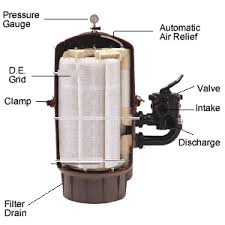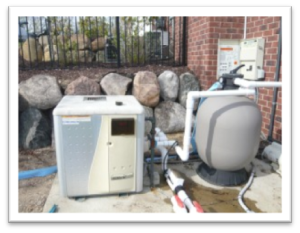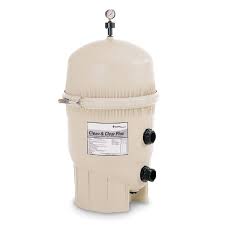Filters are essential for any type of pool. They keep the water clean by filtering the water through some form of filter medium. The pool water then returns to the pool in tip-top condition. There are many different types of pool filters and it’s important to browse your options to figure out which one works best for you.
Sand filters are the most common type of pool filter. They work well for domestic and commercial pools. They actually use sand to filter the pool water. The water passes through a tank filled with very finely graded sand, and the impurities attach themselves to the grains of sand. The large particles of debris become trapped a the surface of the sand bed. The water then cycles back into your pool.
One of the perks of sand filters is their simplicity. They are easy to maintain and to identify problems. If the bed of sand becomes clogged with dirt, the pressure inside the filter will be registered on a gauge. You will then know there is a need to flush or backwash the filter. To do this, simply switch off the pump and turn valve to ‘backwash’. This will reverse the water flow and send the clog down the line. This whole process only takes about two minutes.
Sand filters are heavy-duty but they will need to be replaced around every five years. This will change depending on pool size and pool usage.
Cartridge filters use filters inside the filter tank. The filter material is folded into the tank. It has a large surface area, which increases the filter cycle. Unlike most other filters, cartridge filters don’t have a backwashing function. When the cartridge is clogged, it has to be removed for cleaning. Usually hosing off is all that’s necessary, but those used in a heated pool or spa oftentimes need to be soaked in a cleaning solution. This will eliminate the opportunity for bacteria growth. A cartridge filter can wear out over time and need to eventually be replaced.
Diatomaceous Earth (DE) Filters:
DE is a powder made up of finely crushed coral-like rock. It is actually fossilized exoskeletons of tiny diatoms. (Who knows why someone thought to do this-but it works!). Each grain of ED has a microscopic hole running through it. It works by trapping even the finest particles. Diatomaceous earth is added to the filter when you mix it with water and add it into the skimmer box. Do this while the pump is running. When it is sucked into the filter, it will form a cake on the outside of the pad. When water passes through the pad it also passes through this collection of DE. This is where the filtering takes place. This ‘cake’ drops from the pad when the pump is no longer running, then forms again when the pump is started.
This type of filtration works well because the grains of DE are extremely fine. It can remove particles from the water down to five microns in size. When the pressure rises in the filter, this typically means the DE cake is clogged. This will require backwashing.
Backwashing DE filters is the same as it is for sand filters. However, after backwashing, the DE material will be washed away and will need to be re-added to your skimmer basket to repeat the process. In order for this whole system to work properly, the septums inside the filter will also need to be removed once a year and hosed off.
Have more filtration questions? Contact us at Ask the Pool Guy! We can help you research and purchase a filter that will work perfectly for you and your family.


